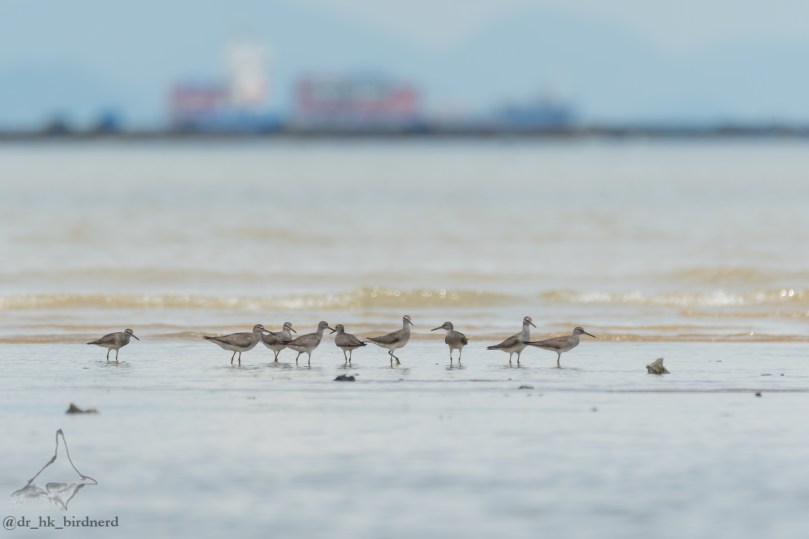Hong Kong has an impressive diversity of ecosystems and, correspondingly, birding sites. Though many of the top hot spots are well-known, newly discovered and sometimes unexpected ones continue to pop up as adventurous birders explore less-frequented places in Hong Kong. Both the Hong Kong Birdwatching Society and the popular website Birding Hong Kong have their own respective lists of the usual spots, and I would recommend going there for specific suggestions of where to go.
Here, I just want to list the general kinds of environments you’ll find productive for birding in Hong Kong.
Farmland and Wetlands:

The main concentration of Hong Kong’s wetlands lie in the northwest part of the territory along the coast of Deep Bay (Shenzhen Bay). Furthest inland and across the Mainland border is Mai Po Marshes, a government-protected wildlife sanctuary. It is by far the most productive, pristine, and exciting place to see many migrating and wintering wetland birds from throughout the hemisphere, though gaining access to it is a bit of a hassle. (I have actually never been there personally.)
Beyond Mai Po, however, is a network of wetlands and semi-aquatic farmland surrounding the Kam Tin River and extending down to Lau Fau Shan. The area, however, is being rapidly developed, and so more of these wetlands areas are at risk of being lost. Hong Kong Wetland Park itself, for example, sits in between two high-rise construction sites, with the surrounding apartments in the area all being relatively new and built on reclaimed wetlands or farmland.
But there are pockets of similar environments scattered throughout Hong Kong that are worth exploring for migrants and visitors. Long Valley, for example, is an exciting oasis and well-known inland spot that attracts a variety of waders throughout the migrating year, as well as many species of buntings. Certain village areas in Hong Kong do tend to have farmland, so there may be less well-known areas that are similarly even if not equally productive. The same goes for wetlands.
Woodlands:

Hong Kong’s forests are all relatively young, having been mostly clear-cut shortly before 1860, when Hong Kong’s country parks began to be established and wildlife began to be monitored. It wasn’t until the 1950s that people started to notice the forests reaching a level of maturity to attract a number of locally-occurring species from surrounding southern China and Southeast Asia. Since then, biodiversity in Hong Kong’s forests has exploded, with many species successfully colonizing and enriching them.
Additionally, human activity and especially pet trade has introduced a number of species into Hong Kong’s forests that just so happened to thrive. These include such forest regulars as black-throated laughingthrushes, greater-necklaced laughingthrushes, yellow-cheeked tits, velvet-fronted nuthatches, and silver-eared mesia. The laughingthrushes I find most numerously on western Hong Kong island. I rarely fail to see or at least hear them whenever I visit, and they’re rather fearless there, perhaps due to how well-trafficked those parks are. The tits and nuthatches often appear in “bird waves” together in Tai Po Kau, and seldom elsewhere.
The mountains in the central new territories host the most dense and mature forests, particularly Tai Po Kau Nature Reserve and the adjacent Tai Mo Shan Country Park. Tai Lam Country Park is also well-forested. Additionally worth exploring is the largely forested northeastern part of the territory, including Sai Kung East Country Park, Plover Cove Country Park, and Pat Sin Leng Country Park. Not all of the forests in these parks are equally mature, and the mountains here are mostly bare, so exploration in these areas is demanding, but also often rewarding.
Urban Parks:
Birding in parks can be surprisingly rewarding. Some beautiful urban parks in Hong Kong, particularly those with waterworks, are uniquely reliable and surprisingly accessible places to see impressive residents, visitors, and vagrants. Some parks in Hong Kong are well-known kingfisher spots, for example, while others quite randomly host unexpected but impressive guests, such as flycatchers and thrushes.
Crowds in parks, however, are something to consider. Additionally, photographers will often set up perches and use bait to attract and keep a bird or birds in the same area for days or even weeks at a time. Escaped birds often end up drawing such crowds, though such escapees are usually quickly identified as such.
Islands and Sea
Hong Kong’s rocky coasts and islands along its eastern and southern expanses is home to a number of important islands for migrating and breeding birds. The island of Po Toi, for example, particularly in the springtime, turns up many of the rarest of Hong Kong’s records, as the island, along with its small and rocky neighbors, hosts many passage migrants and seabirds.

Hong Kong’s rocky marine islands also host a number of successful breeding sites for terns, especially bridled terns and black-naped terns. Other migrating and vagrant seabirds from the South Pacific and elsewhere visit these coasts as well, though the only way to really explore these coasts is by boat.
SAFETY TIP: USE CAUTION AND COMMON SENSE WHEN YOU BIRD. You may run into language barriers, transport barriers, or even safety issues if you are exploring remote areas. Many remote villages and farmlands have local dogs that roam free; paths are not always well-marked; phone service may be spotty or nonexistent; minibus schedules may be erratic, and so on.

